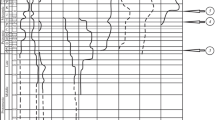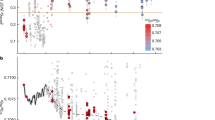Abstract
The Ccarb masses per time unit was determined for separate oceanic basins and for the entire World Ocean using lithological–facies mapping of the Neo– and Eopleistocene age sections of the Pleistocene pelagic zones in the World Ocean. These parameters are compared with those of continents, continental shelves and slopes, and oceans, which were recalculated using data by Ronov (1993) for the Upper Jurassic–Pliocene. At the Mesozoic–Cenozoic boundary, carbonate accumulation was shifted from continents to oceans. The accumulation of carbonate sediments on continents is determined by areas of epicontinental seas. Significant role in the history of oceanic carbonate sedimentation is played by the nutrient fluxes from continents into the World Ocean. Subduction and evolution of the carbonate compensation depth (CCD) play significant role in calculating the quantitative parameters of carbonate accumulation in ocean.
Similar content being viewed by others
References
W. H. Berger, “Calcite Compensation Depth (CCD),” Encyclopedia of Marine Geosciences (Springer, 2016), pp. 71–73.
W. H. Berger and E. L. Winterer, “Plate stratigraphy and the fluctuating carbonate line,” Pelagic Sediments: On Land and Under the Sea, Ed. by K. J. Hsü and H. C. Jenkyns (Blackwell, Oxford, 1974), pp. 11–98.
R. A. Berner, “GEOCARBSULF: A combined model for Phanerozoic atmospheric O2 and CO2,” Geochim. Cosmochim. Acta 70, 5653–5664 (2006).
N. M. Chumakov, Earth’s Glaciations. History, Stratigraphic Significance, and Role in the Biosphere (GEOS, Moscow, 2015) [in Russian].
C. P. Conrad and C. Lithgow–Bertelloni, “Faster seafloor spreading and lithosphere production during the mid–Cenozoic,” Geology 35 (1), 29–32 (2007).
J. W. Farrell I. Raffi, T. R. Janecek, D. W. Murray, M. A. Levitan, K. A. Dadley, K.–C. Emeis, M. Lyle, J.–A. Flores, and S. Hovan, “Late Neogene sedimentation patterns in the eastern equatorial Pacific,” Proc. ODP, Sci. Results 138, 717–756 (1995).
Geological–Geophysical Atlas of the Atlantic Ocean, Ed. by G. B. Udintsev, (MOK (YUNESCO)–MINGEO USSR–AN USSR–GUGK USSR, Moscow, 1989–1990). [in Russian].
Geological–Geophysical Atlas of the Indian Ocean, Ed. by G. B. Udintsev (Akad. nauk SSSR, Moscow, 1975) [in Russian].
F. M. Gradstein, J. G. Ogg, M. D. Schmitz, and G. M. Ogg, The Geologic Time Scale 2012 (Elsevier, Amsterdam, 2012).
W. W. Hay, L. S. Sloan, and C. N. Wold, “Mass/Age distribution and composition of sediments on the ocean floor and the global rate of sediment subduction,” J. Geophys. Res. 93 (B12), 14933–14940 (1988).
International Geological–Geophysical Atlas of the Pacific Ocean, Ed. by G. B. Udintsev, (MOK (YUNESCO), RAN, GUNIO MORF, Moscow–St. Petersburg, 2003) [in Russian].
V. N. Ivanenkov, “General tendencies in distribution of biogenic elements in the World Ocean”, in Chemistry of Ocean Waters, Ed. by O. K. Bordovskii and V. N. Ivanenkov (Nauka, Moscow, 1979), pp. 188–228 [in Russian].
J. M. Kennett, Marine Geology (Prentice–Hall, Englewood Cliffs, 1982).
V. E. Khain, Tectonics of Continents and Oceans (Moscow, Nauchnyi Mir, 2001) [in Russian].
K. S. D. Kochhann, A. Holbourn, W. Kuhnt, J. E. T. Channell, M. Lyle, J. K. Shackford, R. H. Wilkens, and N. Andersen, “Eccentricity pacing of eastern equatorial Pacific carbonate dissolution cycles during the Miocene climatic optimum,” Paleoceanography 31, (2016) doi 10.1002/2016PA002988
V. G. Kuznetsov, Evolution of Carbonate Accumulation in the Earth’s History (GEOS, Moscow, 2003) [in Russian].
V. G. Kuznetsov, “Evolutionary section of lithology: emergence, state, and relationships of rock formation with evolution of the organic world,” in A Review of Conceptual Problems of Lithology, Ed. by O. V. Yapaskurt (GEOS, Moscow, 2012), pp. 34–70 [in Russian].
M. A. Levitan, “Diagenesis (and catagenesis) of carbonate deposits,” in Geological History of Ocean, Ed. by A. S. Monin and A. P. Lisitzin (Nauka, Moscow, 1980a) pp. 342–348 [in Russian].
M. A. Levitan, “Hiatuses in the sedimentary cover of the Atlantic Ocean,” Byul. Mosk. O–va Ispyt. Prir., Otd. Geol. 55 (3), 111–116.(1980b).
M. A. Levitan, “Quantitative parameters of Pleistocene pelagic sedimentation in the World Ocean: global trends and regional features,” Geochem. Int. 55 (5), 428–441 (2017).
M. A. Levitan, and Yu. A. Bogdanov, “History of carbonate accumulation,” in Geological History of Ocean, Ed. by A. S. Monin and A. P. Lisitzin (Nauka, Moscow, 1980), pp. 260–277 [in Russian].
M. A. Levitan, Paleooceanology of the Indian Ocean in the Cretaceous–Pliocene (Nauka, Moscow, 1992) [in Russian].
M. A. Levitan and T. N. Gelvi, “Quantitative parameters of Pleistocene pelagic sedimentation in the Atlantic Ocean,” Geochem. Int. 54 (12), 1049–1060 (2016).
M. A. Levitan, Kh. M. Saidova, and O. B. Dmitrenko, “Some features of planktonogenic carbonate accumulation in the Indian Ocean in Cenozoic,” Okeanologiya 27 (1), 82–88 (1987).
M. A. Levitan, A. N. Balukhovsky, T. A. Antonova, and T. N. Gelvi, “Quantitative parameters of Pleistocene pelagic sedimentation in the Pacific Ocean,” Geochem. Int. 51 (5), 345–352 (2013).
M. A. Levitan, T. A. Antonova, and T. N. Gelvi, “Facies structure and quantitative parameters of Pleistocene pelagic sedimentation in the Indian Ocean,” Geochem. Int. 52 (4), 316–324 (2014).
A. P. Lisitzin, Processes of Oceanic Sedimentation (Nauka, Moscow, 1978) [in Russian].
L. M. Mejía, A. Méndez–Vicente, L. Abrevaya, K. T. Lawrence, C. Ladlow, C. Bolton, I. Cacho, and H. Stoll, “A diatom record of CO2 decline since the late Miocene,” Earth Planet. Sci. Lett. 479, 18–33 (2017).
R. D. Müller, M. Sdrolias, K. Gaina, B. Steinberger, and Ch. Heine, “Long–term sea–level fluctuations driven by ocean basin dynamics,” Science 319, 1357–1362 (2008).
M. Pagani, M. Huber, Z. Liu, S. M. Bohaty, J. Hendriks, W. Sijp, S. Krishnan, and R. M. DeConto, “The role of carbon dioxide during the onset of Antarctic Glaciation,” Science 334, 1261–1264 (2011).
A. T. S. Ramsay, “The distribution of calcium carbonate in deep sea sediments,” Paleoceanography, Ed. by W. W. Hay, SEPM Spec. Publ. 20, 57–76 (1974).
A. B. Ronov, Sedimentation History and Oscillatory Movements in the European Part of the USSR (Geofiz. Inst. Akad. Nauk SSSR, Moscow, 1949) [in Russian].
A. B. Ronov, Sedimentary Cover of the Earth: Quantitative Tendencies of Structure, Composition, and Evolution (Nauka, Moscow, 1980) [in Russian].
A. B. Ronov, Stratisphere or Sedimentary Cover of the Earth (Nauka, Moscow, 1993) [in Russian].
A. B. Ronov, “Phanerozoic transgressions and regressions on the continents: a quantitative approach based on areas flooded by the sea and areas of marine and continental deposition,” Am. J. Sci. 294, 777–801 (1994).
A. B. Ronov, V. E. Khain, and A. N. Balukhovsky, “Global quantitative sedimentation balance on continents and oceans for the last 150 Ma,” Izv. Akad. Nauk SSSR, Ser. Geol., No. 1, 3–11 (1986).
A. Ronov, V. Khain, and A. Balukhovsky, Atlas of Lithological– Paleogeographical Maps of the World. Mesozoic and Cenozoic of Continents and Oceans (Mingeo, Leningrad, 1989).
V. S. Savenko, and A. V. Savenko, Phosphorus Geochemistry in the Global Hydrological Cycle (GEOS, Moscow, 2007) [in Russian].
M. Steinberg, “Fluctuations of the accumulation rate of the sediments deposited in the South Atlantic Ocean during the last 120 m.y.,” Compt. Rend. de l’Acad. Des Sci. 308. Ser. II (10), 941–946 (1989).
J. Thiede and W. U. Ehrmann, “Late Mesozoic and Cenozoic sediment flux to the central North Atlantic,” North Atlantic Paleoceanography, Ed. by C. P. Summerhayes and N. J. Shackleton, Geol. Soc. Amer. Spec. Publ. 21, 3–15 (1986).
T. Tyrrell and R. E. Zeebe, “History of carbonate ion concentration over the last 100 million years,” Geochim. Cosmochim. Acta 68 (17), 3521–3530 (2004).
T. H. Van Andel, C. R. Heath, and T. C. Moore, “Cenozoic tectonics, sedimentation and paleoceanography of the central equatorial Pacific,” Geol. Soc. Amer. Mem. 143, 1–65 (1975).
J. Zachos, M. Pagani, L. Sloan, E. Thomas, and K. Billups, “Trends, rhythms, and aberrations in global climate 65 Ma to Present,” Science 292, 868–893 (2001).
Author information
Authors and Affiliations
Corresponding author
Additional information
Original Russian Text © M.A. Levitan, 2018, published in Geokhimiya, 2018, No. 7.
Rights and permissions
About this article
Cite this article
Levitan, M.A. Fractionation of Carbonate Carbon (Ccarb) Accumulation between Continents and Oceans in the Late Mesozoic–Cenozoic. Geochem. Int. 56, 702–710 (2018). https://doi.org/10.1134/S0016702918070066
Received:
Accepted:
Published:
Issue Date:
DOI: https://doi.org/10.1134/S0016702918070066




